Free State, South Africa
Assessing regional small scale and commercial farming systems
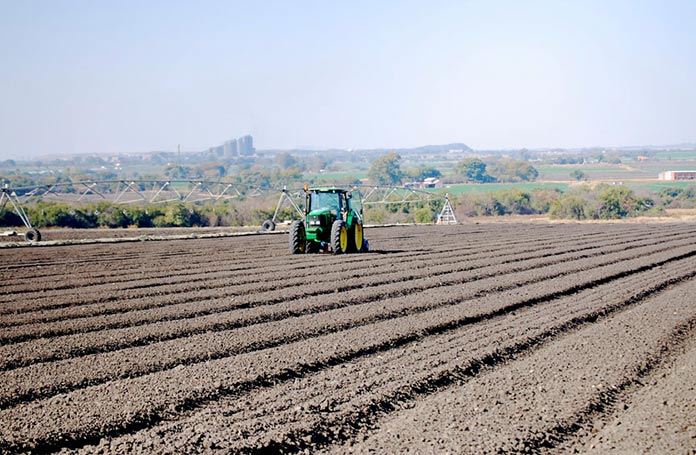
Current Farming System
Commercial and
small scale farms
Rain-fed & Irrigated
Maize, Wheat, Sorghum
Improved soil
Semi-arid

CLIMATE 2050s
Increase in temperatures up to 2°C
Precipitation changes uncertain

Impacts
With current management and future climate:
Maize yields decrease between 10% and 16%
Dryland Wheat yields will be significantly lower
Irrigated Wheat yields will remain the same

VULNERABILITY 2050s
Yield revenue is projected to decrease between 9% and 28%
Higher risks of crop losses and below normal yields increase financial risks due to high inputs costs
Small scale farms more vulnerable

Adaptations
Moving planting dates, more heat tolerant varieties and higher yielding cultivars have the possibility to mitigate the effects of climate change
Conservation practices to preserve soil moisture are also beneficial
 Results Overview
Results Overview
In South Africa, 38,000 commercial farms account for 95% of locally-produced food. The remaining 5% is produced by the country's 220,000 emerging farmers and 1.3 million subsistence farmers (see also Commercial farms ensure SA food security (2012), in Learn More). To continue meeting an increasing demand for affordable food, South Africa's farmers feel they are increasingly challenged by the emerging impacts of climate variability and climate change on production, as well as by volatility in the global markets.
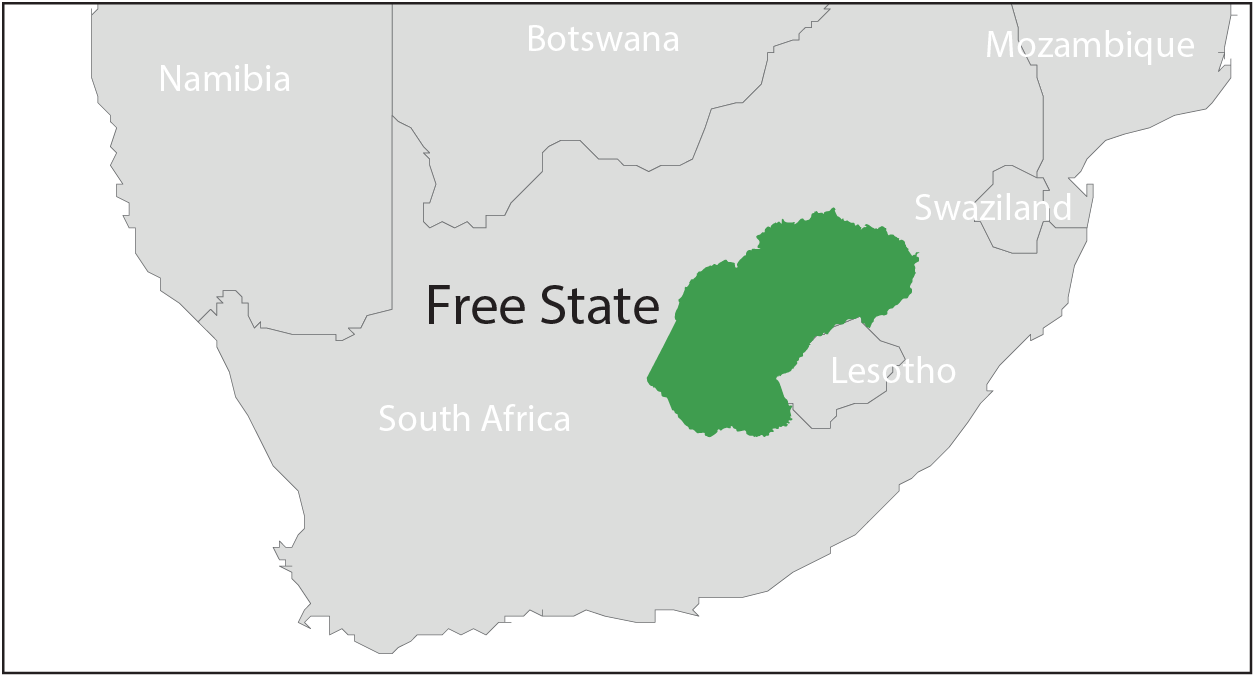
Traditional smallholder farmer yields are low compared to average large-scale commercial and export farmer yields. The difference in yield production, along with additional factors, suggests climate variability and climate change impacts the diverse farm population differently. The interdisciplinary approach to this research, integrating climate, crop, and economic analysis, helps to shed light on the ways in which different communities may be impacted in variable ways.
Southern Africa is a predominantly semi-arid region with high rainfall variability, characterized by frequent droughts and floods. The climate is highly seasonal with hot, wet summers and cool, dry winters. Minimum and maximum temperatures are projected to increase over the whole Free State province. The projected change is notable by (1) its consistency across models and (2) its non-seasonality: the increase is of similar amplitude independently of the season/month of year. Unlike temperature, rainfall projections are inconsistent across models, with some showing positive and other negative changes in mean rainfall.
When considering the Free States' current management practices under future climate conditions, dryland maize and sorghum yields for the whole Free State are projected to remain relatively constant, with modest increases in some regions. These changes can be attributed to cool regions becoming warmer which will benefit plant development, and hotter regions in which crops are not sensitive to a 2°C increase. However, current management practices under drier future conditions will likely cause production to decrease in the cropping areas where most of the Free State maize is currently produced.
Unlike maize and sorghum, dryland (rain-fed) wheat yields under the current management system and future climate are projected to be significantly lower. Wheat, a winter crop, relies on the residual soil moisture from the previous wet season and the onset of rains with the following wet season. Even under future management systems that include conservation agriculture, this yield reduction will not be offset. Inter-annual yield variations are also quite large. With current profit margins on wheat already low, the added risk in planting associated with climate change will likely result in less production of dryland wheat. This could mean additional imports will be needed to meet the local demand.
Under current management and future climate, irrigated maize yields will be lower than they are today. Irrigated wheat will, on the other hand, will remain relatively constant. While this suggests irrigation management could be a viable adaptation mechanism for climate change impacts on wheat, the current management system is too inefficient for effectiveness. Lower future yields can be attributed to the temperature sensitivity of plants growing the under non-water stressed conditions.
For the two summer crops, dryland maize and sorghum, the least favorable climate outlook for future yields occurred with the lowest temperature increase and drier future, for both crop models.
While conservation agriculture may play a minor role in mitigating the effects of climate change, adaptation may potentially have significant impact. Later planting dates, higher yielding cultivars, and heat tolerant cultivars could immensely offset the effects of future climate change. These adaptation measures could allow for dryland wheat yields and irrigated maize yields to remain fairly consistent with current yield levels.
 Farming System
Farming System

Farms in the Free State
The Free State, centrally located in South Africa, is one of nine provinces. Agriculture dominates the landscape. About 40% of the total national white maize production, mainly used for human consumption, and 38% of yellow maize, mainly used for animal feed, is produced in the Free State. Commercial farms account for approximately 95% of all locally produced food. Food security is largely linked to direct and indirect access to cash for purchasing food. The link between cash and food security is the result of the rapid urbanizing of the population - 61.7% of the population resides in urban areas today. The urban demand for affordable food prices, in conjunction with volatile global market prices and negative climate change and variability impacts on production, may make agricultural decisions difficult in the coming future.
The Free State's climate is characterized by warm to hot summers and cool to cold winters. This semi-desert area also brings fluctuations of temperature from day to night. Areas in the east experience frequent snowfalls, some of high precipitation, whilst the west can be extremely hot in summer. Almost all precipitation falls during the summer as brief afternoon thunderstorms, with aridity increasing towards the west. Frost occurs throughout the region usually from May to early September in the west and up to early October in the east.
Agriculture dominates the Free State landscape, with cultivated land covering 32,000 km2, and natural veld and grazing a further 87,000 km2 of the province (Figure I2-1). Field crops account for almost two-thirds of the gross agricultural income of the province. Animal products contribute a further 30%, with the balance generated by horticulture.
About 40% of the total national white maize production, mainly used for human consumption, and 38% of yellow maize, mainly used for animal feed, is produced in the Free State. In addition, soybean, sorghum, sunflower and wheat are cultivated in the eastern Free State, where farmers also specialize in seed production. About 40% of the country's potato yield comes from the province's high-lying areas. The province is a major contributor to food security for the entire country and maintains a considerable labor absorption rate. In 2010, agriculture contributed 3.8% to the provincial economy and accounted for 19.2% of all formal employment opportunities. In addition, this sector contributed about 8% to the country's agricultural output.
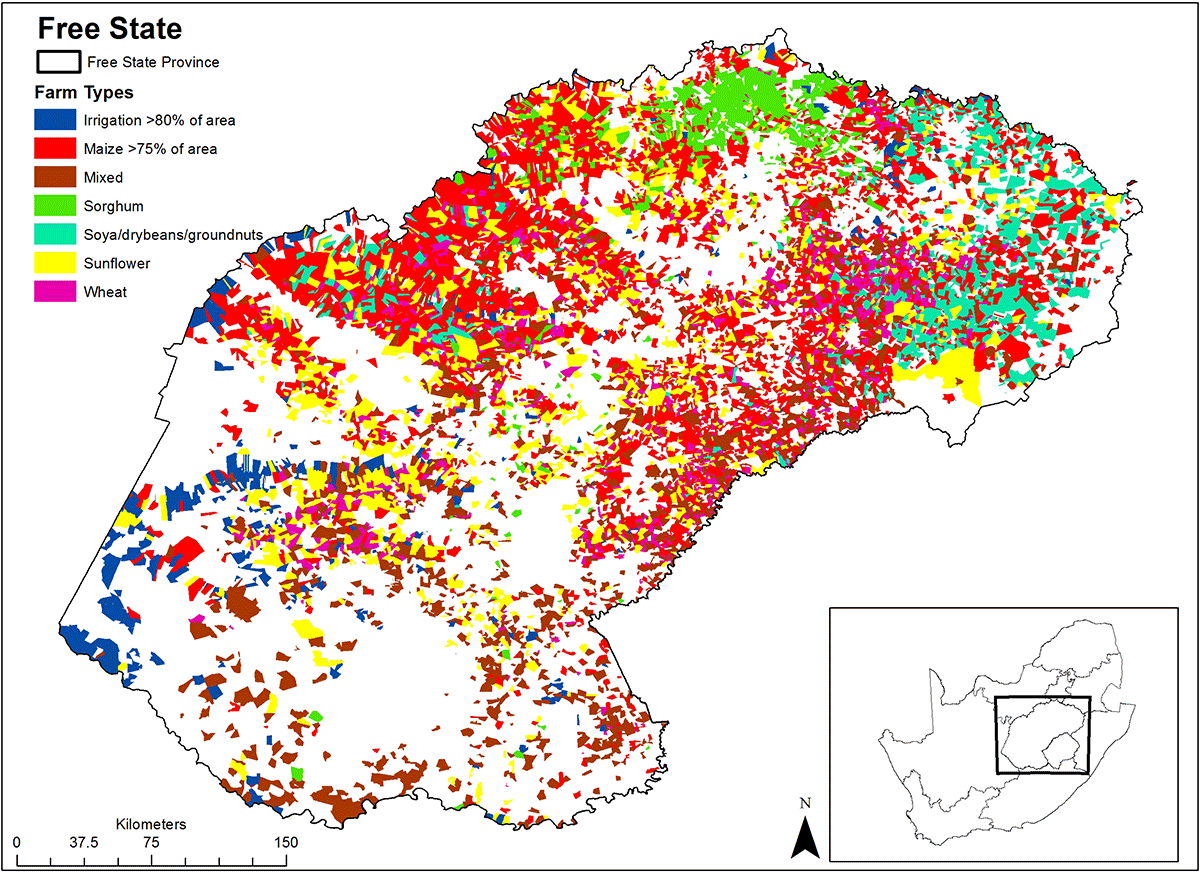
Stratification of seven different farming types in the Free State based on the crop planted.
The total area of production has declined for both maize and wheat, whilst yields have increased significantly in the recent past.
Improved maize and wheat cultivars have allowed for increased yields despite a decline in total harvested area. The yields for sorghum have been relatively stable, though there has been a drastic decline in total production area. This land has been converted to growing soybean and sunflower.
The recent past demonstrates there have already been some changes to agricultural distribution. The shift in South Africa's food consumption and diet preferences to a more Western diet, along with the influences of free trade, has encouraged farmers to reduce total land dedicated to wheat production. As wheat prices have reduced, the value of sunflower and soybean has increased. Farmers have found profit in producing sunflower for oil and margarine, while also producing soybeans for animal feed to produce and sustain the growing demand for "red" and "white" meat.
Current challenges in commercial agriculture include droughts, floods, policy uncertainty, farm attacks, high input costs, wage increases, and new pests and diseases. One of the most important questions facing the Free State is whether climate change impacts amplified by current challenges will threaten Free State's status as the food basket of South Africa in the coming future.
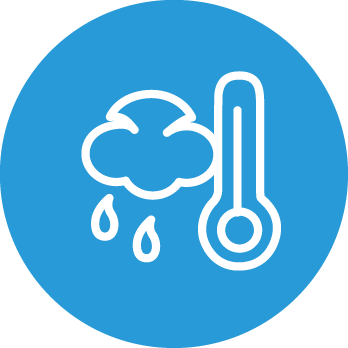 Climate Change Projections
Climate Change Projections
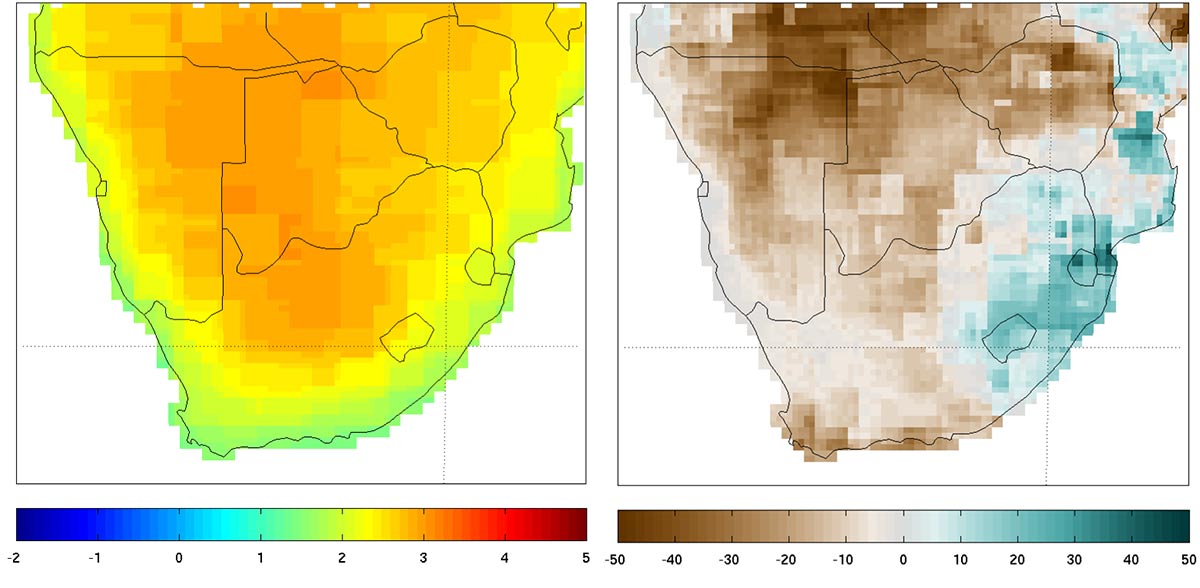
Median changes in June-September growing season (left) temperature (oC) and (right) total precipitation (mm) from 29 climate model simulations for South Africa and surrounding countries in the 2050s under a high emissions climate change scenario, compared with the 1980-2010 historical period.
Generally, minimum and maximum temperatures are consistently increasing over the entire Free State province. Climate models, regardless of emissions projections, agree temperatures increase more each year into the future. Additionally, the climate models demonstrate the increases in temperature are similar amplitude regardless of season/month.
Unlike temperature, rainfall projections are inconsistent across models and project both positive and negative changes of varying amounts. This inconsistency and uncertainty has made it difficult to develop any confidence in rainfall projections across the Free State. Recently, a decrease in rain amount has been observed during the historic month of wet season onset, which could result from either a reduction of intensity, frequency, and/or onset of the early rains. However, the record of observation is insufficient to show any statistical significance to date.
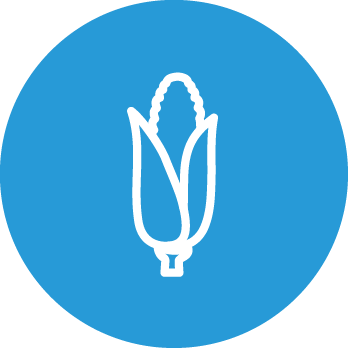 Climate Change Impacts
Climate Change Impacts
Current System
If current farming systems were used in the future, climate change impacts would result in lower than expected yields and higher risk of crop "losses" / below break-even yield levels. The large variance in rainfall occurrence, together with higher temperatures, would lead to higher risk of crop loss and damage from drier periods during critical crop development stages (such as the flowering stage in maize). Temperature changes could encourage pests and diseases to spread to new areas, potentially causing negative impacts on net yields. Given that crop production already has low profit margins and high input costs, these higher risks of crop losses would result in an increase of financial risk and financial loss due to below break-even yields.
Future System
Future systems under future climate are just as sensitive to future climate as are the current systems. However, there are some indications that the effect of climate change on inter-annual variability can be compensated through adaptation measures such as conservation agriculture under both moderate and high emission conditions. These measures seem to indicate dryland maize and dryland sorghum will not be affected by an increase of up to a 2°C in mean annual temperature. Conversely, dryland wheat - a winter crop – and irrigated maize will be negatively affected by the anticipated change in climate. The only consistent outcome seems to arise under moderately increased temperature and rainfall reduction, under which conditions all crops will be negatively affected.
 Vulnerability
Vulnerability
Vulnerability refers to farms likely to incur losses from climate change.
Two future scenarios were developed to assess future farm vulnerability. These two Representative Agricultural Pathways (RAPs) are described below:
RAP Sustainable development - Low carbon green economy with sustainable growth
In the Green Road, following the example of high-income countries, South Africa may start to invest in renewable energies that will increase efficiencies at all levels. With the aid of financial investments by the high-income countries in its economy, South Africa may be better able to address poverty and social inequalities. Good governance will lead to stable environments where special care is given to humanitarian issues such as policing, health care and education in urban and rural areas. Changes in tax structure may allow for increased exports, but could also enable the establishment of new markets. There may be increased uptake of conservation focused climate smart agriculture and organic agriculture, and an overall greater awareness of the importance of healthy ecosystems surrounding farming activities. Agriculture could either be i) high intensity using less land; or ii) low intensity on larger areas of land.
RAP Fossil fuel development - A grey road with high growth extractive primary
In this RAP, the traditional export markets of South Africa may be restricted to products that are in demand by specific countries. This could lead to competition with other countries to fill the niche. At the same time, the authoritarian government could decide that agriculture should be a service provider to the poor, as a form of job creation, and preferentially supports this process. To be competitive, export oriented agriculture may become more industrialized, with large, high intensity, and highly mechanized farms. This could result in the shedding of jobs in the agriculture sector. People therefore may move to towns and cities to find employment. This would in turn cause rapid urbanization and pressure on the service provision, education and healthcare sectors. There could be less foreign investment and aid money flowing into the country because the traditional donors could have their own crises at hand. As a result, investment in health, education and technologies may be largely government dependent. Meanwhile, government may have preferentially invested in non-green energies and infrastructure to fulfill terms of international loans. The concurrent relaxation of environmental regulation could result in expansion in industries and mining, leading to an increase in immigration. The economy may be somewhat tenuous but relatively stable compared to other countries in the region.
 Adaptations
Adaptations
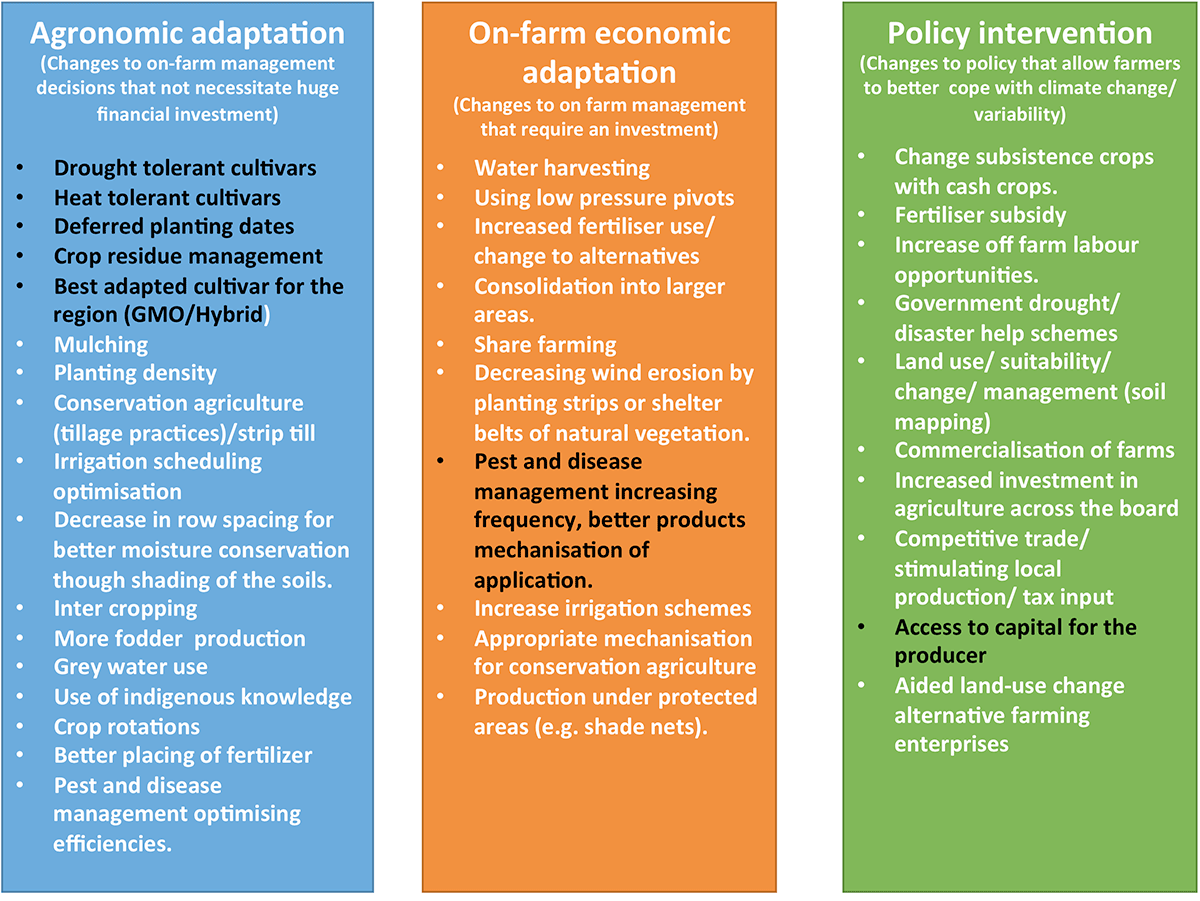
Table of adaptations presented to stakeholders. The black highlighted adaptations were voted to be used in the commercial farming sector in the study.
Although commercial, small-scale, and subsistence farming communities face many common challenges related to their exposure to climate variability and change, their adaptive capacities are vastly different.
Small-scale farmers are more vulnerable due to difficulties to finance the high costs of inputs such as improved seed varieties. They have limited access to updated knowledge and agricultural techniques for water and soil conservation and are rarely able to set long-term plans. In addition to temperature and drought-related challenges, small-scale farmers are concerned about soil erosion, water logging and livestock diseases. The commercial farmer population has already addressed these, as efficient adaptation strategies have been put in place.
The major obstacle hindering commercial farmers with future planning is the lack of clear directives from the government, for example, with regard to issuing of water licenses and land reform.
Closing the yield gap remains the priority for subsistence and small scale farming sectors in Free State. These farmers will focus upon changes in their management and the better use of available technology (eg. adapted cultivars, precision farming methods, better pesticides). These adaptations would focus on moving / deferring the optimum planting date (window) as well as use of drought / heat tolerant cultivars. The overall application of conservation practices to preserve soil moisture (within season and between seasons) to overcome the dryer periods between rainfall events would also become more general practice. The result of the application of these and similar practices reduces the risk of crop failure / losses and increases the likelihood of achieved yields approaching potential yields.
In contrast, the commercial farmers are looking to increase entrepreneurial and financially sagacious farming strategies, anticipating changes toward increasingly global and open markets. This includes increased uptake of all aspects of conservation agriculture, precision farming, adoption of GMOs, vertical integration, consolidation and innovation. Identified ways forward include knowledge transfer within and across farming communities (commercial to small scale), clear governmental directives and targeted locally adapted finance programs.
 Stakeholder Engagement
Stakeholder Engagement
 Theater for dissemination.
Theater for dissemination.
The South Africa Team's approach to stakeholder engagement was based upon specific objectives and purposes, mainly data collection, message refinement, and dissemination. Stakeholders were engaged individually and in groups. Engagement was done primarily for reflection on emerging messages to ensure model relevance, for sharing information and data to foster relevant and useful project outputs, and for building or sustaining longer-term relationships.
Participatory workshops were used to engage a wide range of stakeholders to solicit input for the Representative Agricultural Pathways (RAP) and identification of Adaptation Packages.
Facilitated workshops engaged stakeholders in refinement of key messages, and identification of areas where the information could be useful and/or extension to additional dissemination platforms for further uptake. Workshops also enabled the regular sharing of information, practices, results and key messages, including identification of what stakeholders are currently doing in relation to climate change and exploration of possible areas for further collaboration.
Theatre for Dissemination
The theatre was also adopted as an alternative approach to stakeholder engagement. This is an innovative way to make meaning of the science for audiences far beyond the researchers, to facilitate getting AgMIP results into decision processes. It was designed and used to clarify AgMIP's value add in a fairly crowded and complicated research space (climate change modeling), and could be used to target dissemination to affected groups.
 Learn More
Learn More
This research was made possible by generous support from the UK Department for International Development's UKaid.
This research is a part of the AgMIP Southern Africa region project; more information is available here.
Southern Africa Team Members
| Olivier Crespo | Co-Lead PI; Climate and Agriculture |
| Wiltrud Durand | Co-Lead PI; Crop modeling |
| Hlami Ngwenya | Co-PI; Stakeholder liaison |
| Agyapong B. Gyeke | Co-PI; Economist |
| Thembeka Mpusaing | Botswana Coordinator |
| Mogos Y. Teweldemedhin | Namibia Coordinator |
| Joseph J. Baloyi | Livestock |
| Weldemichael A. Tesfhuney | Information Technology |
| Petru Fourie | Economist |
| Eyob Tesfarmariam | Stakeholder liaison |
| Matthew Jones | Crop modeling |
Affiliated Institutions
University of Cape Town
Agricultural Research Council-GCI
Facilitation of Systemic Change Consulting (FSCC)
Botswana University of Agriculture and Natural Resources
Botswana College of Agriculture University of the Free State
Free State Department of Agriculture and Rural Development
James Hutton Institute
References
Commercial farms ensure SA food security, 2012 Commercial farms ensure SA food security, 2012. Fin24. 08 August. Available: https://www.google.com/url?q=http://www.fin24.com/Economy/Commercial-farms-ens ure-SA-food-security-20120808&sa=D&ust=1490774064701000&usg=AFQjCNFe3O6i5Fi vm8uvAiiQIN63FKdIiQ
Kok, 2017 Kok, A., 2017. Hiér lé die kiem vir misdaad. Die Burger, page 9. 18 February. Available: http://www.pressreader.com/south-africa/die-burger/20170218/
Rosenzweig and Hillel, 2015 Rosenzweig, C., and D. Hillel, Eds., 2015. Handbook of Climate Change and Agroecosystems: The Agricultural Model Intercomparison and Improvement Project (AgMIP) Integrated Crop and Economic Assessments. London: Imperial press.
Schulze, R.E. 2007 Preface and Executive Summary. In: Schulze, R.E. (Ed). 2007. South African Atlas of Climatology and Agrohydrology. Water Research Commission, Pretoria, RSA, WRC Report 1489/1/06, Section 1.1.
